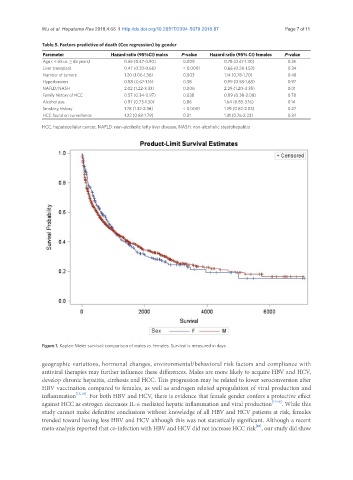Page 742 - Read Online
P. 742
Wu et al. Hepatoma Res 2018;4:66 I http://dx.doi.org/10.20517/2394-5079.2018.87 Page 7 of 11
Table 5. Factors predictive of death (Cox regression) by gender
Parameter Hazard ratio (95%CI) males P-value Hazard ratio (95% CI) females P-value
Age ( < 65 vs. ≥ 65 years) 0.65 (0.47-0.90) 0.009 0.78 (0.47-1.30) 0.35
Liver transplant 0.47 (0.33-0.68) < 0.0001 0.66 (0.28-1.53) 0.34
Number of tumors 1.20 (1.06-1.36) 0.003 1.14 (0.78-1.70) 0.48
Hypertension 0.88 (0.67-1.16) 0.38 0.99 (0.58-1.68) 0.97
NAFLD/NASH 2.02 (1.22-3.33) 0.006 2.29 (1.20-4.35) 0.01
Family history of HCC 0.57 (0.34-0.97) 0.038 0.89 (0.38-2.08) 0.78
Alcohol use 0.97 (0.73-1.30) 0.86 1.64 (0.85-3.16) 0.14
Smoking history 1.78 (1.32-2.38) < 0.0001 1.29 (0.82-2.03) 0.27
HCC found on surveillance 1.22 (0.83-1.79) 0.31 1.31 (0.76-2.23) 0.34
HCC: hepatocellular cancer; NAFLD: non-alcoholic fatty liver disease; NASH: non-alcoholic steatohepatitis
Figure 1. Kaplan-Meier survival: comparison of males vs. females. Survival is measured in days
geographic variations, hormonal changes, environmental/behavioral risk factors and compliance with
antiviral therapies may further influence these differences. Males are more likely to acquire HBV and HCV,
develop chronic hepatitis, cirrhosis and HCC. This progression may be related to lower seroconversion after
HBV vaccination compared to females, as well as androgen related upregulation of viral production and
inflammation [15,16] . For both HBV and HCV, there is evidence that female gender confers a protective effect
against HCC as estrogen decreases IL-6 mediated hepatic inflammation and viral production [17-19] . While this
study cannot make definitive conclusions without knowledge of all HBV and HCV patients at risk, females
trended toward having less HBV and HCV although this was not statistically significant. Although a recent
[20]
meta-analysis reported that co-infection with HBV and HCV did not increase HCC risk , our study did show

